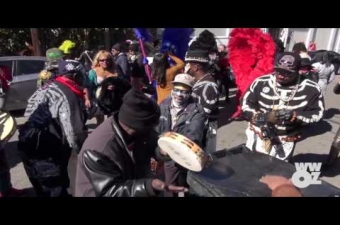
Treme
Located directly across North Rampart Street from the French Quarter, Treme is arguably the oldest Black neighborhood in the country, and one of the most influential in shaping popular American music. As early as 1726, free people of color lived along Bayou Road and enslaved Africans practiced sacred traditions of music and dance in a nearby commons. The area was subdivided as an urban neighborhood in the 1810s, leaving a square block of the commons, Congo Square, as greenspace (gatherings of enslaved people continued there, under increasing regulation, through the mid-19th century).
Treme became fairly diverse later in the 1800s as Sicilians and other European immigrants arrived, but the neighborhood was strongly associated with its French-speaking Afro Creole community. Historians Joseph Logsdon and Caryn Cosse Bell note that Creoles of color, among other distinctions, were known for embracing “dance, music, … ritualized festivals, and marching bands.” Music venues in the 19th century included churches and meeting halls of the benevolent societies that were integral to social life here.
While Treme doesn’t stand alone as the “Birthplace of Jazz”—the artform developed across the city—a high concentration of its pioneers lived here. These include the Tio family, influential clarinet players and teachers; Armand Piron, violinist and popular bandleader; Freddie Keppard, the “cornet king” after the legendary Buddy Bolden; and Alphonse Picou, clarinet ace and manager of a bar in the neighborhood. Others, including Bolden, Sidney Bechet, and Kid Ory, came to Treme to perform at dance halls in the early 1900s.
The streets themselves were often full of music. The density of benevolent societies along with funeral homes and cemeteries in the area made brass band parades and jazz funerals common. Young people played homemade instruments on street corners, and early jazz bands promoted gigs by playing on flatbeds pulled through the neighborhood. On Mardi Gras Day, Black Masking Indians (also known as Mardi Gras Indians) and Baby Dolls rolled with musical accompaniment, often gathering under the canopy of live oaks on North Claiborne Avenue.
In the middle of the 20th century, segregation intensified across New Orleans and Treme became increasingly Black. Neighborhood bars and nightclubs emerged as venues for the remnants of Black vaudeville acts and big bands, then, after World War II, for the city’s brand of rhythm and blues. It’s no coincidence that some of the greatest drummers of the R&B era—including Earl Palmer, Smokey Johnson, and James Black—grew up in Treme. “The difference is the bass drum,” Johnson told writer Bunny Matthews. “That comes from hearing them street parades, them marching bands.” Palmer brought the parade beat into J&M Studios, which faced Treme on Rampart Street, recording seminal R&B hits with Fats Domino, Little Richard, and others, giving rise to rock ‘n’ roll.
In the late 1960s two public works projects transformed Treme. The construction of an elevated expressway along North Claiborne devastated what had been a corridor of Black businesses (including record labels, Houston’s School of Music, and the Black musicians’ union) and a tree-shaded promenade for parades. The demolitions that claimed the Batiste family home came soon after. Years of divestment followed.
Despite these losses—and, in part, in response to them—Treme was at the heart of a brass band and second line renaissance that began in the 1970s and gathered momentum through the 1990s. New generations of musical families like the Andrews infused brass band music with R&B, funk, and hip-hop, and a new wave of social aid and pleasure clubs (descendants of 19th century benevolent societies), Baby Dolls, and Skull and Bone gangs reinvigorated local parading traditions. At the same time, music programs in neighborhood schools produced scores of young artists including Mannie Fresh, the multiplatinum-selling producer for Cash Money Records, who brought the sounds of New Orleans streets back to the top of the national charts.
Following Hurricane Katrina in 2005, public policy once again forced a mass displacement from Treme. With renters largely ineligible for recovery assistance and public housing complexes demolished, many longtime residents were priced out of the neighborhood, which rapidly gentrified (it was 92% Black before the flood and 57% Black in 2018). Before the COVID-19 outbreak in 2020, the Candlelight Lounge was the last live music club in the area.
Today, if music no longer infuses daily life in Treme like it used to, culture bearers have a heightened sense of purpose in keeping local traditions alive. Events like second lines, funerals, and Mardi Gras parades continue to fill the streets as they have since the 19th century, and drum circles and festivals continue in Congo Square, now inside Armstrong Park.
Videos

From Charisse Gibson at WWLTV in 2019, part one of "Treme: Death of a Neighborhood, Survival of a Culture."
Video by WWLTV.
From Charisse Gibson at WWLTV in 2019, part one of "Treme: Death of a Neighborhood, Survival of a Culture."

From Charisse Gibson at WWLTV in 2019, part two of "Treme: Death of a Neighborhood, Survival of a Culture."
Video by WWLTV.
From Charisse Gibson at WWLTV in 2019, part two of "Treme: Death of a Neighborhood, Survival of a Culture."

A glimpse of Mardi Gras Day 2016 in Treme: outside the Backstreet Cultural Museum, Big Chief Charles Taylor and members of the North Side Skull & Bones Gang including Bruce "Sunpie" Barnes bust out "Shoo Fly Don't Bother Me."
Video by WWOZ
A glimpse of Mardi Gras Day 2016 in Treme: outside the Backstreet Cultural Museum, Big Chief Charles Taylor and members of the North Side Skull & Bones Gang including Bruce "Sunpie" Barnes bust out "Shoo Fly Don't Bother Me."
Images















